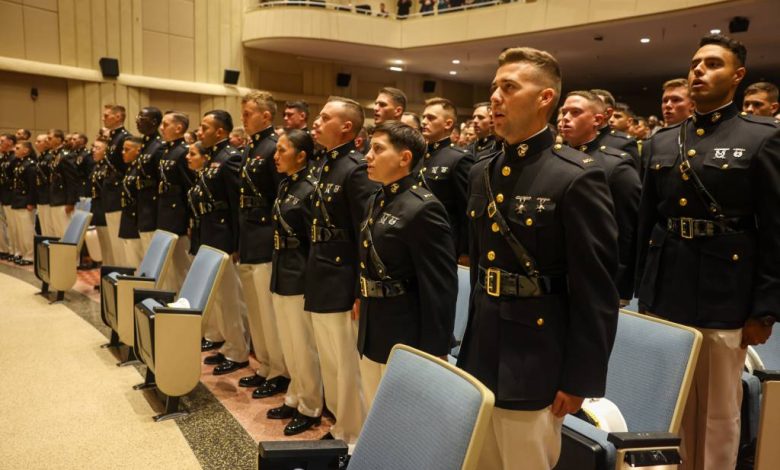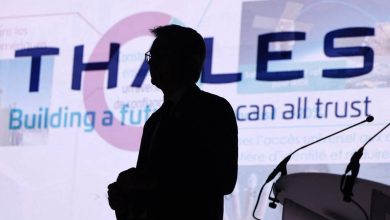Marine training shifts may add tech, change officer assignments

Marine Corps changes to training and education in 2024 and in the coming years will establish more training teams, build a career path for instructors, add advanced technology and could alter how new officers are assigned jobs.
The Corps’ first Training and Education annual report on Force Design published Wednesday ― and the 14-page document noted moves made and laid out deadlines in areas across the service for modernizing how Marines learn.
Lt. Gen. Kevin Iiams, head of Training and Education Command, said in a press release that the document was the command’s “strategic vision” to implement education that matches modernization in Force Design and new equipment and technologies entering the ranks.
“These initiatives collectively aim to equip the Marine Corps with the most modern, lethal, and capable Marines conceivable,” Iiams said. “Our efforts have been, and will continue to be, centered on two core pillars: Force Design and modernization. By driving innovation along these vectors, (Training and Education Command) is ensuring the development of a Marine Corps force primed not only to compete but to dominate in any theater of operation.”
RELATED
The Training and Education 2030 planning document released in January 2023, under then-Commandant Gen. David Berger, laid out gaps in doctrine for such skills as drone and cyber operations, and emphasized modernizing training simulators and other education technologies.
Changes in training could have a direct, early impact on Marines in fires or communications jobs and new officers.
Training command has undertaken a two-phased study with combat development and integration to examine the “quality spread” policy used at The Basic School when assigning new officer military occupational specialties.
The quality spread is used to ensure that top finishers and lower-ranking graduates are spread evenly across the various job fields to avoid bunching up lower performers in one job field.
In its first phase, the study evaluated if evidence supports whether the policy should continue. Those results are expected by the end of June.
If it is found deficient, then the second phase of the study will build an alternate assignment model. That phase is scheduled to conclude before October.
Using a series of recent studies, the Marines plan to determine if measures testing an individual’s resiliency to help “screen out those who may be more susceptible to stress or adverse behaviors” to help lower attrition rates.
The Corps launched a pilot program in April at Marine Detachment Fort Sill, Oklahoma, to build a course for field artillery officers, target acquisition officers and field artillery scout observer chiefs.
The course aims to give those fires Marines in fires and effects coordination centers or fleet maritime operations centers advanced training.
The communication training battalion at Training Command is assessing how to combine critical skillsets from three communications job fields, 062X, 063X and 067X. That merging of those skills would make a more versatile communications Marine for multidisciplinary, “independent communications and information operators.”
As the Corps adopted its new training and education approach, it was evaluating how its instructors taught students and how the instructors themselves were selected and retained.
From that three-year evaluation has come an “outcomes-based learning” approach method. That method, while common in other education circles, has been less prevalent in military education. The approach puts more emphasis on having instructors guide students who learn both individually and in groups, completing tasks and problem-solving.
This is a break from the lecture model with an expert rattling off information at the front of a classroom for students to repeat on a test or quiz before moving to the next assignment.
The outcomes-based learning model will spread across the Corps, as the service has updated its formal school policy directives to include these methods.
“Instead of teaching them what to think, we’re teaching them how to think,” Col. Karl Arbogast, director of the policy and standards division at Training and Education Command, told Marine Corps Times in a previous interview.
But to teach this way requires training the instructors as well.
That’s resulted in two new exceptional military occupational specialty codes: 0951 and 0952. These are in addition to a Marine’s primary job but allow them to learn how to instruct.
The basic instructor course will be available to Marines by the end of fiscal year 2024 with the intermediate and master courses ready by fiscal year 2026, according to this week’s report.
Training Command is assessing both selection and retention of such qualified instructors, according to the report, and analyzing current and future incentive options to retain high-performing instructors.
On the technology side, the Corps has migrated its legacy information management system to a hybrid cloud system. The service expects to have a new, cloud-based version of the system fully operational by fiscal year 2028.
Tech moves are expanding war-gaming access through cloud services and expect to have war-gaming featured in all formal schools and primary military education by fiscal year 2025 and across the fleet by fiscal year 2026.
Also in the tech vein, the service will have deployed live, virtual, constructed training simulators to Marine Corps Air Ground Combat Center, Twentynine Palms, California, Camp Pendleton, California and Marine Corps Bases Hawaii and Okinawa, Japan, before October.
At the same time, each Marine expeditionary force and the Marine air-ground task force training command will receive one battalion-capable Marine Corps Tactical Instrumentation System by summer.
The training command is preparing to field electromagnetic spectrum simulators at Twentynine Palms, California, that can replicate adversary electronic warfare capabilities in training.
The Marines plan to use simulators to cut down on injuries as well.
They have a project underway to identify ground training events that have a high rate of injury, mishap or casualty. They’ll then include simulator training prior to live execution of those types of training events, starting with the motor transport tasks before October.
Lastly, to cut down on Marines awaiting training for schools, the new policy will identify Marines prior to recruit training graduation who will wait longer than 10 days between Marine Combat Training and their follow-on school and assign them to the Permissive Recruiter Assistance Support Program.
Also, Marines in lengthy awaiting training periods will be offered a voluntary reclassification to a job that is experiencing shortfalls and an immediate school ship date.
Todd South has written about crime, courts, government and the military for multiple publications since 2004 and was named a 2014 Pulitzer finalist for a co-written project on witness intimidation. Todd is a Marine veteran of the Iraq War.
Read the full article here






